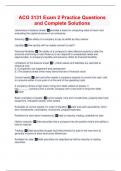ACG 3131 Exam 2 Practice Questions
and Complete Solutions
Usefulness of balance sheet: ✅provides a basis for computing rates of return and
evaluating the capital structure of an enterprise.
Solvency ✅the ability of a company to pay its debts as they mature.
Liquidity ✅How quickly will my assets convert to cash?
Financial flexibility ✅The ability of a company to take effective actions to alter the
amounts and timing of cash flows so it can respond to unexpected needs and
opportunities. A company's liquidity and solvency affect its financial flexibility.
Limitations of the balance sheet ✅1.) Most assets and liabilities are reported at
historical cost
2.) Companies use judgement and assessment
3.) The balance sheet omits many items that are of financial value
Current assets ✅cash and other assets a company expects to convert into cash, sell,
or consume either in one year or at the end of the operating cycle
A company carries a high level of long-term debt relative to assets, it
has________solvency than a similar company with a low level of long-term debt.
✅lower
Basic examples of assets: ✅current assets, long term investments, property plant and
equipment, intangible assets, other assets
Examples of current assets: (In order of liquidity) ✅cash and cash equivalents, short
term investments, receivables, inventories, prepaid expenses
Portfolios for short term investments; ✅held to maturity, trading, available for sale
Held to maturity: ✅Debt securities that a company has the positive intent and ability to
hold to maturity.
Trading: ✅Debt securities bought and held primarily for sale in the near term to
generate income on short-term price differences
Available for sale: ✅Debt securities not classified as held-to-maturity or trading
securities.
, Inventories ✅To present inventories properly, a company discloses the basis of
valuation (e.g., lower-of-cost-or-net realizable value or lower-of-cost-or-market) and the
cost flow assumption used (e.g., FIFO or LIFO).
Prepaid expenses ✅A company includes prepaid expenses in current assets if it will
receive benefits (usually services) within one year or the operating cycle, whichever is
longer.
Examples of non-current assets: ✅long term investments, property plant and
equipment, intangible assets, other assets
4 types of longterm invesments: ✅investments in securities such as bonds common
stock and long term notes
Investments in tangible fixed assets not currently used in operations such as land held
for speculation
Investments set aside in special funds such as a sinking fund, pension fund
Property, plant and equipment ✅tangible long-lived assets used in the regular
operations of the business. These assets consist of physical property such as land,
buildings, machinery, furniture, tools, and wasting resources (timberland, minerals).
Intangible assets ✅lack physical substance and are not financial instruments (for the
definition of a financial instrument). They include patents, copyrights, franchises,
goodwill, trademarks, trade names, and customer lists
Other assets ✅Some include items such as long-term prepaid expenses, prepaid
pension cost, and noncurrent receivables. Other items that might be included are assets
in special funds, deferred income taxes, property held for sale, and restricted cash or
securities.
Current Liabilities ✅the obligations that a company reasonably expects to liquidate
either through the use of current assets or the creation of other current liabilities
Examples of current liabilities: ✅1.Payables resulting from the acquisition of goods and
services: accounts payable, wages payable, taxes payable, and so on.
2.Collections received in advance for the delivery of goods or performance of services,
such as unearned rent revenue or unearned subscriptions revenue.
3.Other liabilities whose liquidation will take place within the operating cycle, such as
the portion of long-term bonds to be paid in the current period or short-term obligations
arising from the purchase of equipment.
Working capital ✅The excess of total current assets over total current liabilities




